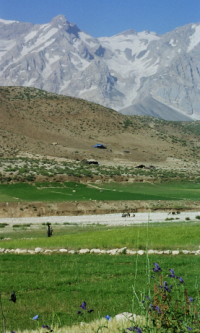
Photo. Nice people from the Bakhtiari nomads. The Bakhtiari nomads living high up in the mountain hillsides. The scenery with snow capped summits in the background was something for itself! © Travel Explorations.
The good smells from the beautiful Shabdar flowers that grow around created a unique atmosphere. When I approached the nomads I could see it started to be activities in the small camps. People looked curious out from the tents, and some of them come toward me. This was the start of a real adventurous journey in Iran.
See the video clip from the brutal Choopy-dance (click on this link): Choopy-dance.
According to my itinerary in July 2004 I travelled around in several regions such as Shahr-e Kod, Yasuj and Kafe Namdoon, which are the residing places or on the immigration routes of the nomads. Today there are over hundred different tribes, each with its own dialect, distinctive dress, dwelling-place and pastures.
I visited the Bakhtiari nomads in Shahr-e Kord region. The Bakhtiari tribe, reside in Khuzestan Province in winter and immigrate to the altitude of Zagros in Chahar Mahal Bakhtiari in summers. Later on my way from Shahr-e Kord to Yasuj, I crossed the Zagros altitudes and visited the Lors (Luri) tribe.
Advertising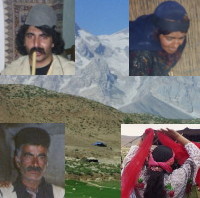 | Contact us in Travel Explorations for advertising. We attract travellers to Iran through inspiring articles, photos and video clip. E-mail: stein@travelexplorations.com |
In Kafe Namdoon I also got the chance to become familiar with the Qashqai tribe. Normally, the Qashqai nomads, being of Turkish race, stay in the south of Fars province and in Bushehr in winter and immigrate to the north parts of Fars, Kohgiluyeh va boyer Ahmar and Yasuj in the summer.
Iran has many unique features of its own in its people, landscapes, arts and customs. One of the things I found most interesting on my journey in this country was the nomads. They were really great!
The Bakhtiari nomads retain its traditional lifestyle and culture
The Bakhtiari nomads, which numbered more than 1 million in 1997, inhabits an area of approximately 67,000 Km (25,000 Mi) that straddles the central Zagros Mountains. They speak a dialect of Persian called Lori (Luri), and are Shiite Muslims. About one third of the tribe is nomadic. The last chieftain (Khan) of the Bakhtiari tribe was Jafar Gholy, whom died last year.
The Bakhtiari nomads are divided into two main groups, the Haft Lang and the Chahar Lang. Further more they are subdivided in turn into several tribes and sub-tribes or tayefeh. Their clothing, with extraordinarily wide trousers, round hat and short tunic, is reminiscent of the Arsasid (Parthian) period, 200 BC-280 AD.
Photo. The Bakhtiari nomads live in wild and harsh landscape, but that didn`t prevent them from smiling. © Travel Explorations. Both adults and children welcomed me everywhere I showed up. | 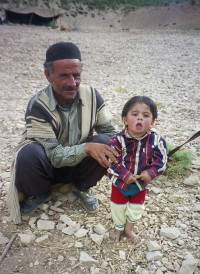 |
Hard life
We started from Esfahan. Our first stop on the way was in the early in the morning. An old man from the Bakhtiari tribe told us about a hard life: bad government, lousy security, no rain, thieves, and high rent for the land. Before the revolution the security was good. Now the security was bad and bandits stole others cattle. Shian was not good, but the times were better in his period.
He and his tribesmen felt misused by the butchers in the market whom pressed down the prices on the cattle. There are some organisations for the tribes, but they do nothing. It's very expensive to buy medical treatment for the animals. There were no alcoholic problems, but little bit drug problems. The only thing he was satisfied with was that he had no boss to tell him what to do. The biggest problem is to feed their animals because of lack of rain. When it rains the mountains become green, and the tribes don't have to pay for feeding their animals.
In the middle of the wilderness
As the sun lightened up the snow capped mountains in the late morning, I was walking up a hillside to visit a group from the Bakhtiari nomad tribe in Iran. I could really feel the heat, and hoped that I would be invited in to a cool tent for a rest. I assume it was ca. 30 degrees Celsius in the shadow, but in the sun it was like a torture walking around. The good smell from the beautiful Shabdar flowers created a unique atmosphere.
Photo. The beautiful Shabdar flowers smelled good, and created a unique atmosphere in the wild landscape. © Travel Explorations. | 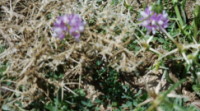 |
Up to the hillside camps
When I approached the nomads I could see it started to be activities in the small camps. People looked curious out from the tents, and some of them come toward me. The children were especially curios, but at same time little bit shy. It didn't took long time before the men show up and invited us immediately in to their resting place.
But first we sat down for a while to relax. I showed the nomads a calendar with photos from my home country Norway. So they started to ask question about me, my family and country. This was a really good conversation, and we all had a good time sitting out in the hot sun. People come from everywhere offering me something to drink and eat.
| Photo. The children were happy to see me, and they were always eager to be in the lense. © Travel Explorations. | 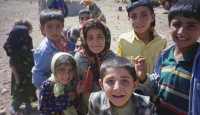 |
Apparently I attracted the children's attention. Some of the children were very shy and turned their face away each time I catches their eyes. Others were eager to shake hands with me. Sometimes I felt that they looked at me as they thought I was an alien from another planet. Afterwards I gave the nice children sweets and balls to play with before I was guided further up to the nomads` resting place. The children become very happy and followed my everywhere.
Photos. The women worked hard: weaving, taking care of children and cooking.
In a big tent I cooled down. It was very nice sitting there together with the tribesmen. I was served tea continuously. The tribesmen served it with both white and yellow sugar which they sucked trough their teeth. I was also served a kind of milk and something I thought was a "white stone". All the tribesmen laughed when I said this was a beautiful stone, and so they explained for me that it was a kind of butter. I tasted it, but it didn't taste good at all, and I needed to save the hard "stone" for a later occasion (when I was hungrier).
Ancient sites in the wild landscape
The tribesmen told me about unexcavated sites nearby, one of the places was called Hosistand, where the sites were not fully excavated or not excavated at all. Some sites have been exposed for looting so there were not much left, but it was still some few interesting things to look for. Bakhtiaria`s ancient objects are only found in cemeteries around in the area.
| Photo. Lion sculptures in a Bakhtiarias`s cemetery symbolise braveness. © Travel Explorations. |  |
Actual the Iranian lion were little bit smaller than the African lion, and was extinguished for over 80 years ago.
The Bakhtiaria`s cemeteries around in the area are very beautiful, but it looked as they were exposed for looters. Photo. Big holy grave in a Bakhtiaria`s cemetery, with a hand that stretch against the sky. © Travel Explorations. | 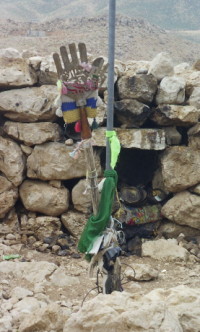 |
Guest in a brick house deep in the valley
Deep in the valley we where stopped by an old man who invited us home to meet his family. This man really nice and told us many interesting stories from his long life. Here we where served a delicious lamb soup and melons.
His family member and friends were eager to display their traditional costumes and weapon. To honour my host I dressed up in their traditional costume with a weapon on my shoulders, which the tribesmen liked very much. Photos. Me in the Bakhtiari`s traditional costumes. © Travel Explorations. | 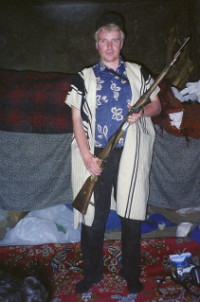 |
Photos. Inside a brick house in the valley. The tribesmen were very proud of their culture, and their hospitality was unique! © Travel Explorations. | 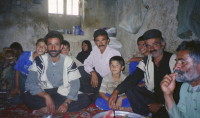 |
This article contiues in Part 2: ....... this hill was a miracle of natural resources.......!
Stein Morten Lund, 8 August 2004
Additional information
Facts about Iran:
Formal country name: Islamic Republic of Iran.
Area: 1.64 million sq km.
Population: 68.27 million.
People: Persian (Farsis) (65%), Azari (25%), Arab (4%), Lors (2%), Turkmen (2%), Kurdish, Armenian, Jewish.
Language: Persian, Kurdish.
Religion: Shi'ite Muslim (89%), Sunni Muslim (10%), Zoroastrian, Jewish, Christian, Baha'i (1%).
Government: Islamic republic.
